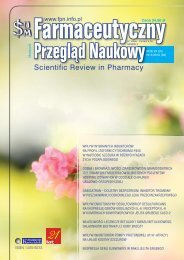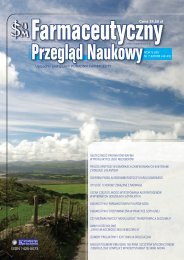Pokaż caÅy numer - FPN - Farmaceutyczny PrzeglÄ d Naukowy
Pokaż caÅy numer - FPN - Farmaceutyczny PrzeglÄ d Naukowy
Pokaż caÅy numer - FPN - Farmaceutyczny PrzeglÄ d Naukowy
You also want an ePaper? Increase the reach of your titles
YUMPU automatically turns print PDFs into web optimized ePapers that Google loves.
copyright © 2009 Grupa dr. A. R. Kwiecińskiego ISSN 1425-5073<br />
phenomenon may be evoked by a decrease of collagen biosynthesis,<br />
increased degradation of this protein or by coexistence<br />
of both phenomena.<br />
Obviously collagen biosynthesis requires energy supply.<br />
Glucose is the main energetic substrate and glycolysis is the main<br />
process which supplies energy for fibroblasts grown in vitro [5].<br />
For these reasons the glucose shortage may reduce intracellular<br />
pool of ATP required for the functions of these cells, including<br />
collagen biosynthesis. Furthermore, the shortage of glucose in<br />
culture medium enhances proteolytic (and gelatinolytic) activity<br />
in these cells [1,6] and may promote collagen degradation.<br />
On the other hand glucose deprivation appeared to be a<br />
factor which induces the expression of oxygen-regulated protein<br />
(ORP) 150 in fibroblast cultures [4]. Oxygen-regulated<br />
protein of molecular weight 150 kDa (ORP150) and glucose<br />
- regulated protein of molecular weight 170 (GRP170) are<br />
endoplasmic reticulum (ER) chaperones, which facilitate<br />
protein folding [2]. The GRP170 is a glycosylated form of<br />
ORP150. The ORP150/GRP170 system is a part of the ER<br />
machinery that assists in the folding and assembly of secretory<br />
and membrane proteins within the ER [3]. The expression<br />
of ORP150 increases in a range of pathologic situations<br />
such as brain ischaemia [7], atherosclerotic plaques [8] and malignant<br />
tumours [9-11] suggesting that ORP150 is a contributory<br />
factor for the cellular response to environmental stress.<br />
The role of ORP150 in cellular physiology remains unclear.<br />
Some observations indicate that ORP150, like GRP78 and<br />
GRP94, is involved in the processing of proteins in the secretory<br />
pathway [12]. This allows suggesting that ORP150 is a chaperon,<br />
which protects intracellular collagen against proteolytic effects<br />
exerted by glucose shortage. In order to test such a hypothesis<br />
we decided to study the effect of glucose deprivation in culture<br />
medium on proline incorporation into total proteins and specifically<br />
into collagenase-sensitive and hydroxyproline-containing<br />
proteins. Furthermore, the degradation of newly synthesised<br />
collagen and correlation of this process with the expression of<br />
glucose-regulated proteins (ORP150/GRP170) was studied.<br />
Materials and methods<br />
Reagents<br />
The DMEM was provided by Invitrogen (San Diego,<br />
USA). Passive lysis buffer (Promega, Madison, USA), monoclonal<br />
anti-human ORP 150 (IBL, Gunma, Japan), highly<br />
purified bacterial collagenase (type VII), Sigma-Fast BCIP/<br />
NBT reagent, alkaline phosphatase-labelled anti-mouse<br />
immunoglobulin G were purchased from Sigma (St Louis,<br />
USA), as were most other chemicals and buffers used.<br />
[2,3,4,5 – 3 H] L-proline was obtained from Hartmann Analytic<br />
(Braunschweig, Germany). Nitrocellulose membranes<br />
(0.2 μm), Sodium dodecyl sulphate-polyacrylamide gel<br />
electrophoresis (SDS-PAGE) molecular weight standards<br />
and Coomassie Brilliant Blue R-250 were purchased from<br />
Bio-Rad Laboratories (Hercules, CA).<br />
Cell cultures<br />
The experiments were performed on the human skin<br />
fibroblast cell line (CRL-1474) purchased from American<br />
Type Culture Collection (ATCC). The cells were cultured in<br />
Dulbecco’s modified Eagle’s medium (DMEM), containing<br />
glucose at 4.5 mg/ml (high glucose DMEM) supplemented<br />
with 10% heat-inactivated foetal calf serum (FCS), 2 mM<br />
L-glutamine, penicillin (100 U/ml) and streptomycin (100<br />
μg/ml). The cells were seeded at a density of 5 x 10 5 cells<br />
in 2 ml medium and grown on six-well plates, in a 5 % CO 2<br />
incubator, at 37 O C.<br />
Experimental procedure<br />
5 x 10 5 cells in 2 ml medium were seeded in six-well plates<br />
and incubated for seven days in the high glucose DMEM. In<br />
these conditions the cultured cells reached 70-80% confluency.<br />
After this time the medium was removed and replaced<br />
with 2 ml of the fresh DMEM (without calf serum):<br />
1. the high glucose DMEM contained 4.5 mg of glucose<br />
per ml (25mM),<br />
2. the low glucose DMEM contained 0.5 mg of glucose per<br />
ml (2.8 mM).<br />
Each was supplemented with [2,3,4,5– 3 H] L-proline,<br />
ascorbate (50 µg/ml), 2 mM L-glutamine, penicillin (100<br />
U/ml) and streptomycin (100 μg/ml). The incubation was<br />
continued for 12, 24, 48 hours. The fibroblast did not divide<br />
during the incubation in serum-free medium. No increase in<br />
cell density was observed in this period.<br />
After incubation the culture media were removed, the cell<br />
layers were washed with PBS and submitted to the action of<br />
lysis buffer. It allowed separating the cells and extracellular<br />
matrix from the bottom of culture vessels and suspending<br />
them in the buffer.<br />
Filtration Assay<br />
Each hydrophilic Durapore membrane (0.65-µm pore<br />
size) was soaked with 250µl of 25% TCA. The cell lysates<br />
and culture media were treated with 50% TCA (final TCA<br />
concentration 25%) and next incubated at 4 o C for 1h. The<br />
formed precipitate was collected on the filter membranes<br />
and separated from the supernatant using a vacuum source<br />
attached to the 1225 Sampling Manifold (Millipore). To<br />
remove all unincorporated [ 3 H]-proline, the filters were<br />
washed 3 times with 5 ml of 10% TCA by vacuum-filtration<br />
through the membrane. After removing the underdrain and<br />
drying, the membranes were then punched out into scintillation<br />
vials and the filter-bound radioactivity was quantified<br />
by liquid scintillation counting [13,14].<br />
The assay of collagenase-sensitive protein<br />
The collagenase-sensitive protein was measured using<br />
the method described by Petrkofsky and Diegelman [15].<br />
The cell lysates and culture media were treated with high purity<br />
bacterial collagenases (type VII-Sigma). N-ethylmaleimide<br />
was applied as an inhibitor of unspecific proteolytic<br />
activity associated with collagenase. The amount of newly<br />
synthesised collagen was expressed in dpm of [ 3 H]-proline,<br />
incorporated into protein susceptible to the action of bacterial<br />
collagenases [15].<br />
Determination of radioactive hydroxyproline<br />
Cell lysate or incubation medium was submitted to hydrolysis<br />
in 6 M HCl, at 100 O C, for 16 h. The hydrolysates<br />
were evaporated to dryness in a rotary glass evaporator. The<br />
33
















